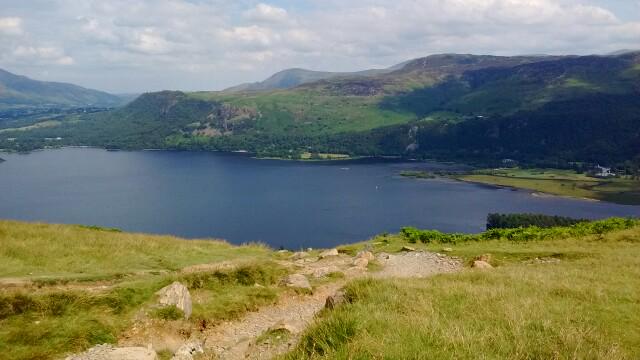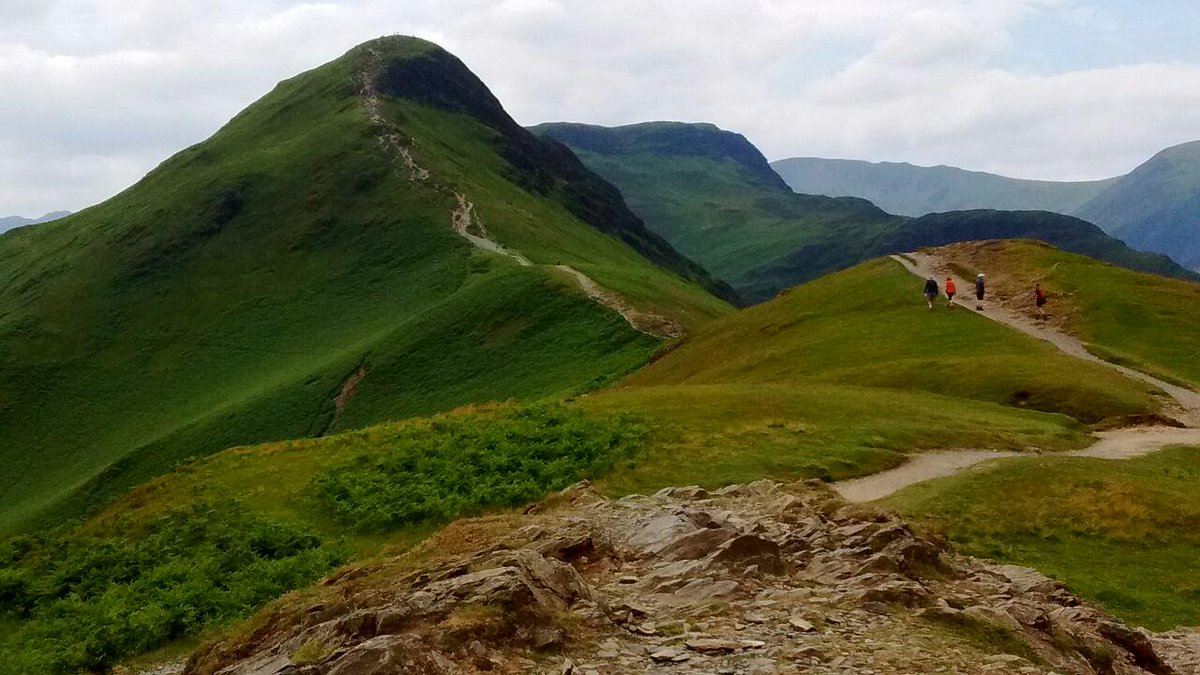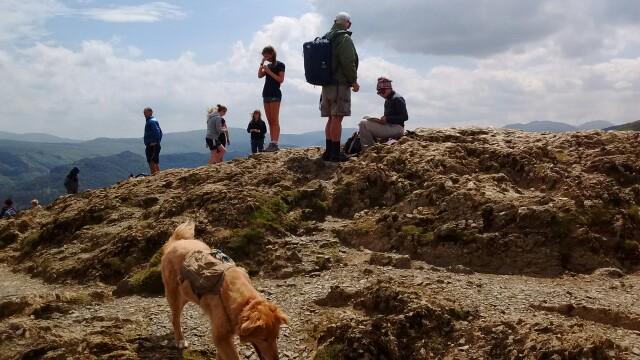We didn't intend to go further than Catbells
We were sat on Hause Gate, just below the hause itself and above the bracken. People came up the long stone pitched path from Manesty past us. At the summit a throng of people milled about, eating lunch, taking in the scenery. It had turned into quite a nice day. Bright, although the wind and the clouds took away the excesses of summer heat. As well as keeping the bugs at bay. Jessie had finished her lunch and was now pulling at the chewing gum embedded in the fur between the pads of her paw. There's a downside to the numbers visiting Cat Bells. I needed, but did not have with me, scissors to be able to cut it out. Later I found it too close to the skin to get it all out. Sometimes people's actions are so thoughtless.

Sat on the side of Hause Gate
It was late when we left Keswick, at least for us. Today's forecast suggested it would improve although the wind would increase into the evening. We crossed the fenced track through the fields to Portinscale under grey, overcast skies. The 'wobbly bridge' did its thing, and we turned south following the Cumbria Way for a bit. Nearing Hawes End we left the Way to head up to the zigzag road above and the path to Skellgill Bank.
I don't usually find myself on Catbells in the summer so it was a novelty to see lush green, very thick bracken beside the path. Purple foxgloves standing proud of the bracken waved to us in the breeze. Frequently stopping to catch my breath I made the excuse of looking around. The view here is a wide, simple pleasure. Skiddaw stands at the head of Derwent Water, lording it over Keswick and the surrounding area. Not even Blencathra, or Saddleback as it's known if you come from east of Threlkeld, has quite the same presence here.

Heading for Catbells summit - lots of people about today
Just below Skellgill Bank attached to a rock step is a memorial plaque to Thomas Arthur Leonard. Considered a social reformer, he founded the Holiday Federation and YHA movements, believing in ordinary workers access to affordable holidays. He was also fundamental in setting up The Ramblers, and in the establishment of the Pennine Way. He was involved in the formation of The National Trust, The Campaign for the Protection of Rural England, and National Parks. Yet he is less well known than John Muir. Certainly an influential figure, but few people who passed by took any notice of the stone that lay in their way. Maybe they'll notice when their rights are all in the past.

On Catbells' summit
Delay at a little rocky step just before the summit gave us a another breather. A steady stream of people toiled up the steep slope behind us. More stood on the summit, including a large group of children complete with adult minders telling off one of their charges for littering. Hurrah! After taking the obligatory photos at the summit we continued along the ridge.

A little waterhole
Jessie hadn't had a drink since we crossed a beck on the way to Hawes End so we set out to find the little hidden waterhole. We found it 100m beyond the summit, not at the circle of reeds standing out on a small plateau, but just to its side, unmarked. How many people know it's here, barely a stones throw from the path?

Jessie waited outside
Crossing the Hause we took a narrow path, little more than a trod, through the bracken to the top of a spoil heap. I'd brought my head torch. The entrance was hewn from the rock by hand in Elizabethan times. Water lay on the floor of the tunnel, the walls were wet and the roof dripped. It didn't seem so inviting. After creeping along, round two corners, I'd had enough. No longer could I see the light from the entrance behind me. Jessie wisely stood waiting when I emerged gratefully back into the sunshine.

After a couple of corners I'd gone in as far as I wanted, and water on the floor was getting deeper
So we ended up eating lunch on the side of the hause looking to the central fells and Derwent Water. Replete, we sat there a while, lost in our own little worlds. Not even the horse flies or midges bothered us much as the wind kept them from flying. As we eventually left to follow the steps down to Manesty it seemed such a nice day to just head back to Keswick quite yet.
Cattle that roam the boggy flats at the southern end of Derwent Water were instead in the fields nearby, away from me, and thankfully away from Jessie. Big black beasts that they are, they don't tend to like dogs. We followed the board walk to the 'Chinese Bridge'1. The River Derwent was shallow and clear below us, a few bits of wood lay on the shingle so heavily saturated that they had sunk. I couldn't see any fish.

Taking the long way home
The Borrowdale Road was busy, and noisy, but we quickly turned off to go behind the Lodore Falls Hotel. Staff sat smoking under the ventilation ducts; more noise and smell. The falls did their thing and after a few minutes contemplation we carried on. A path wound through the trees back to Derwent Water, lichen wisps draped over the branches, birds maybe little jenny wren flitted almost unseen through the undergrowth only movement gives them away. And moss covers anything that pauses for too long. Jessie's world also includes the smells humans miss, she pauses often.
We made a dash past the group of tourists in front, and got onto the wee path by the shore. Shingle slipped under our feet. At least it didn't stick to the gum still in Jessie's paw.

The National Trust Centenary Stones
Reaching the Centenary Stones they were out of the water, a chance to touch them, rough and smooth, machined to mark a moment in time long ago. No signs announce what it's for, which is as it should be. The shoreline gets busier the nearer to Keswick we get. Here we don't pause, just head home.
- This rather fine footbridge is apparently named for its shallow arch which is a significant Chinese style.
Tagged: walks
You can comment on this post in our forum.
Participants in these activities should be aware of and accept these risks and be responsible for their own actions.